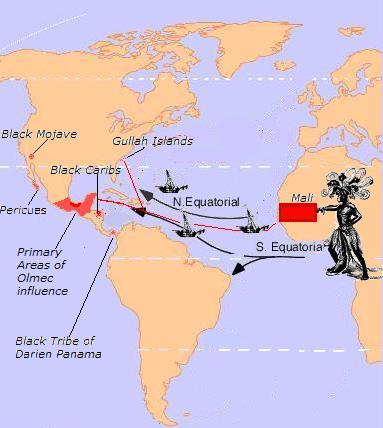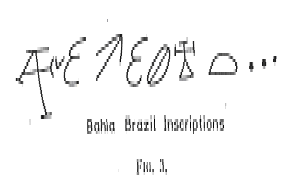 In A.D. 1312, Emperor Abubakari Muhammad , of Mali gave his throne to Mansa Musa and embarked with his fleet into the Atlantic Ocean in search of the continent opposite Africa. Archaeological and epigraphic evidence indicates that Abubakari, and or members of his expedition settled in pre-Columbian Brazil.The Indians have a tradition that Mansar Akban was the leader of another tribe which discovered the Cunan people.This Mansar Akban, may be a reference to Mansa Abubakari, who led the Malian voyagers to the Americas.The Manding lived in mounds along the Niger rivers. The mound cultures of ancient America were built by Africans primarily Manding. The people of the Niger Delta formed river riverine communities which were partly vegetation with some aquatic animals were eaten.The ancient Manding built several types of homes. In ancient times they built masonry houses and cliff dwellings identical to those found in the American Southwest. In Medieval times they lived on mounds in the most watery areas in their circular huts made a stone and wood on the top and their fields in front of the mounds tilled each day.
In A.D. 1312, Emperor Abubakari Muhammad , of Mali gave his throne to Mansa Musa and embarked with his fleet into the Atlantic Ocean in search of the continent opposite Africa. Archaeological and epigraphic evidence indicates that Abubakari, and or members of his expedition settled in pre-Columbian Brazil.The Indians have a tradition that Mansar Akban was the leader of another tribe which discovered the Cunan people.This Mansar Akban, may be a reference to Mansa Abubakari, who led the Malian voyagers to the Americas.The Manding lived in mounds along the Niger rivers. The mound cultures of ancient America were built by Africans primarily Manding. The people of the Niger Delta formed river riverine communities which were partly vegetation with some aquatic animals were eaten.The ancient Manding built several types of homes. In ancient times they built masonry houses and cliff dwellings identical to those found in the American Southwest. In Medieval times they lived on mounds in the most watery areas in their circular huts made a stone and wood on the top and their fields in front of the mounds tilled each day.The Malian people introduced their technology to the Americas. The Manding built dwellings depending on the topography . Near rivers they lived on mounds. In semi-arid regions they lived in cliff houses, like those found in the Southwest. Today the Dogon who trace their descent to the Mande live in identical dwellings as those found in Colorado ,where Manding inscriptions dating to the A.D. 1000 's have been found related to the Pueblo culture.
According to Cadamosto the Mali marines wore white caps on their heads and a white tunic. On the side of the skull-caps worn by the Malian martines, a white wing decoration was emblaxoned, and a feather was stuck in the middle of the skull cap. On board each naval vessel stood a marine with a round leather shield on the arm and a short sword. Other marines were armed with bows and arrows . Murphy reported that the Malian military wore a uniform consisting of sandles, loose fitting cotton breeches reaching down to the knees, a sleeveless tunic, and a white headdress of either cotton or leather, decorated with one or more feathers . The major weapons of the Malian soldier included iron-pointed spears, daggers and short swords, wooden battle-clubs and the bow and arrow . The Malians left many inscriptions in Brazil and elsewhere after they arrived in the Americas. These inscriptions are of two kinds. One group of inscriptions were meant to warn the Manding expeditionary force not to camp in certain areas..
 .
. Inscriptions in this category are found at Piraicaba, Brazil. Another group of inscriptions were left in areas suitable for settlement. Once a safe place was found for settlement, the Manding colonists built stone cities or mound habitations. One of these lost cities was found in A.D. 1753, by banderistas (bandits). .
 .
.Wilkins, reported that these inscriptions were found in the State of Bahia,Brazil by Padre Tellesde Menezes, in Marajo near the Para-oacu and Una rivers engraved over a mausolea. They tell us that the personage buried in the Tomb was named Pe. The most startling evidence of Malians in Brazil , is the "Brazil Tablet", discovered by Col. P.H. Fawcett in an unexplored region near the Culuene river. The interesting thing about this Tablet, was the fact it had "African pigment" and features.
 The most startling evidence of Malians in Brazil , is the "Brazil Tablet", discovered by Col. P.H. Fawcett in an unexplored region near the Culuene river. The interesting thing about this Tablet, was the fact it had "African pigment" and features (printed above) . The personage in this Tablet was an elite of Malian colony in Brazil. Evidence suggesting a Manding origin for the Brazil Tablet are 1) THE CROWN worn by the personage on the tablet; 2) the Manding inscriptions inscribed across the chest and feet of the figure on the Fawcett Tablet; and 3) the evidence of breeches similar to the Manding style military uniform worn by the personage depicted on the Fawcett Tablet.
The most startling evidence of Malians in Brazil , is the "Brazil Tablet", discovered by Col. P.H. Fawcett in an unexplored region near the Culuene river. The interesting thing about this Tablet, was the fact it had "African pigment" and features (printed above) . The personage in this Tablet was an elite of Malian colony in Brazil. Evidence suggesting a Manding origin for the Brazil Tablet are 1) THE CROWN worn by the personage on the tablet; 2) the Manding inscriptions inscribed across the chest and feet of the figure on the Fawcett Tablet; and 3) the evidence of breeches similar to the Manding style military uniform worn by the personage depicted on the Fawcett Tablet.The decipherment of these inscriptions detail the burial place, and cause of death of a Mansa or Mande King. it appears that the Mansa on the Brazil Tablet" was named Be. It tells us that Be, was buried in a hemisphere tomb (i.e.,mound) . The Malians in South America also built their homes on top of mounds. There major centers of habitation appear to have been Panama and Venezuela in addition to Brazil. In Brazil there are many megalithic structures that seem to have there prototype in Africa. For example, in Alagoas we find many stone monuments similar to those found in West Africa, such as stone circles formed by rocks placed vertically on the ground. The habitation mounds in Brazil are called sambuquis. Some of the sambuquis, have radio-carbon dates going back into pre-history, while many of the mounds where artifacts have been found are related to the cultures of Venezuela, and have dates contemporaneous with the Malian voyages. In conclusion the ancient tombs and Brazil tablet indicate that Malians probably landed in Brazil. This is a significant artifact because the elite on the Brazil Tablet, wears a uniform associated with Malian marines. The discovery of a Brazil tomb dedicated to Pe, may in fact be the tomb of Be, who is depicted on the Brazil Tablet.

References:
G. R. Crone, The Voyage of Cadamosto, (London,1937) pp.57-59.
E. Murphy, History of African Civilization, (New York,1972) p.111
.
Harold T. Wilkins, Mysteries of Ancient South America, (Secacus, New Jersey:Citadel Press, 1974), pp.40-45; and Branco, p.146.
Winters, C.A. (1977). The influence of the Mnade scripts on American ancient writing systems. Bulletin de l'IFAN, t.39, Ser.B ,Number 2, 405-431.
Winters, C.A.(1979). Manding writing in the New World--Part 1, Journal of African Civilization, 1 (1), 81-97.
Read more about this in


No comments:
Post a Comment